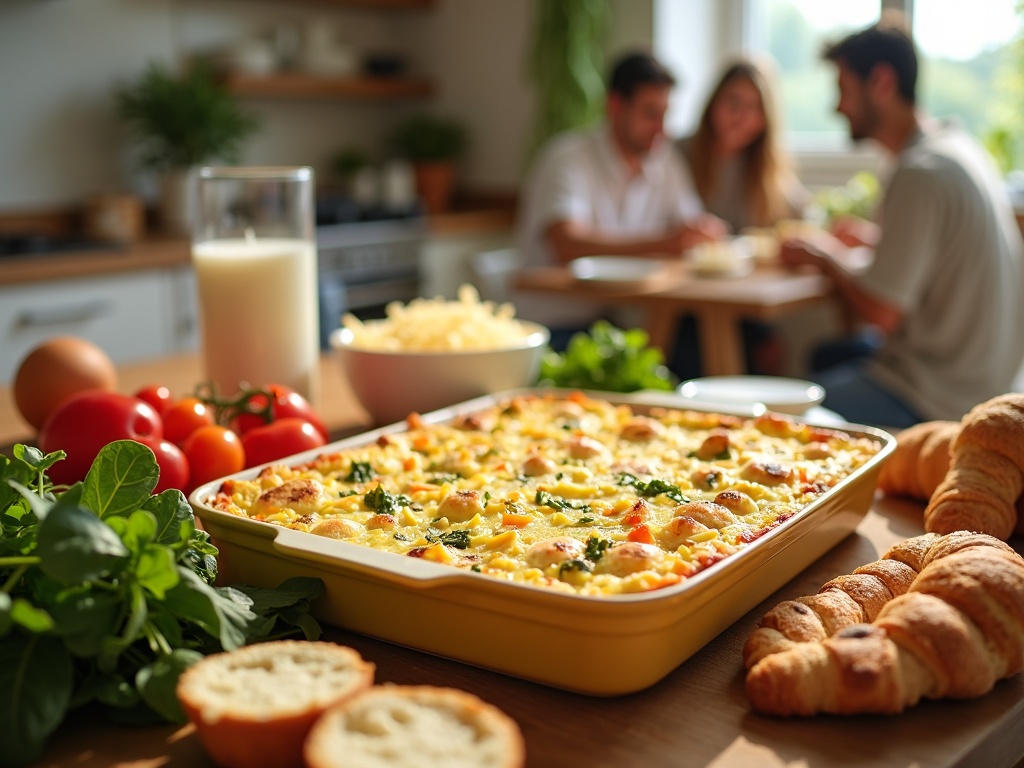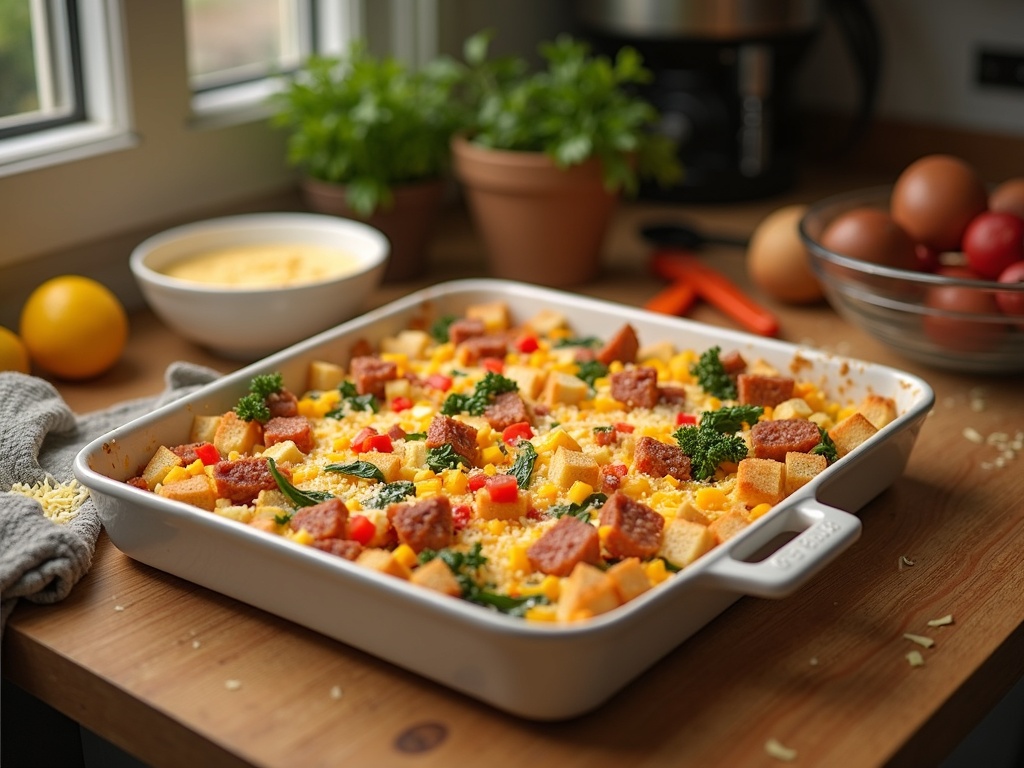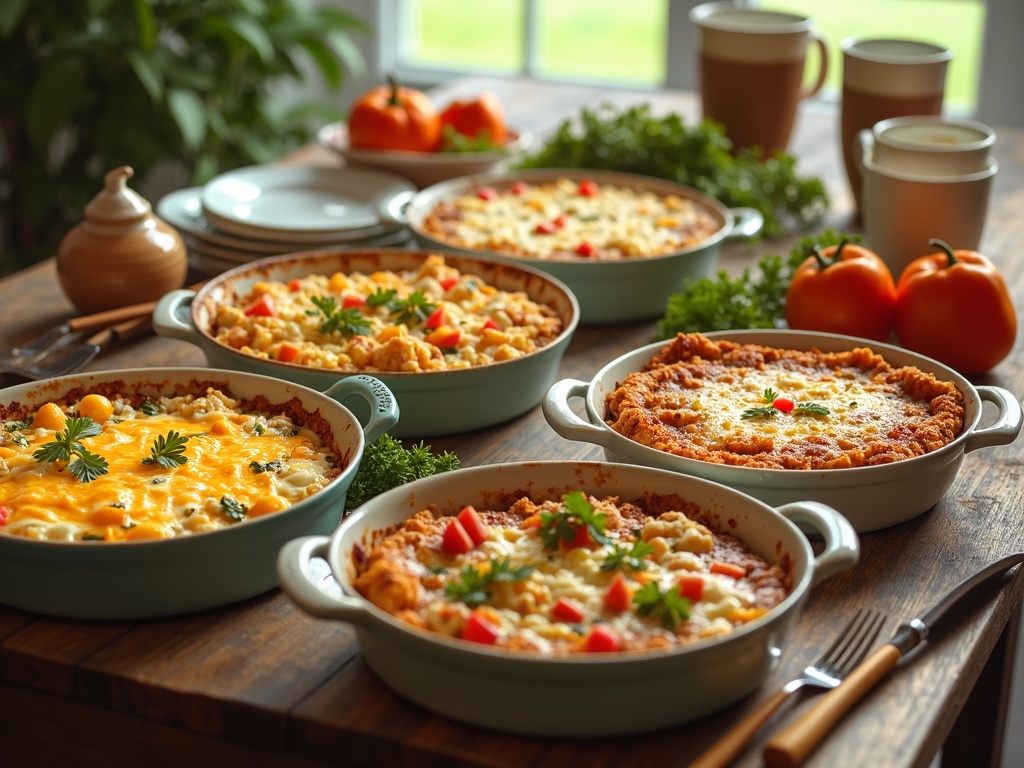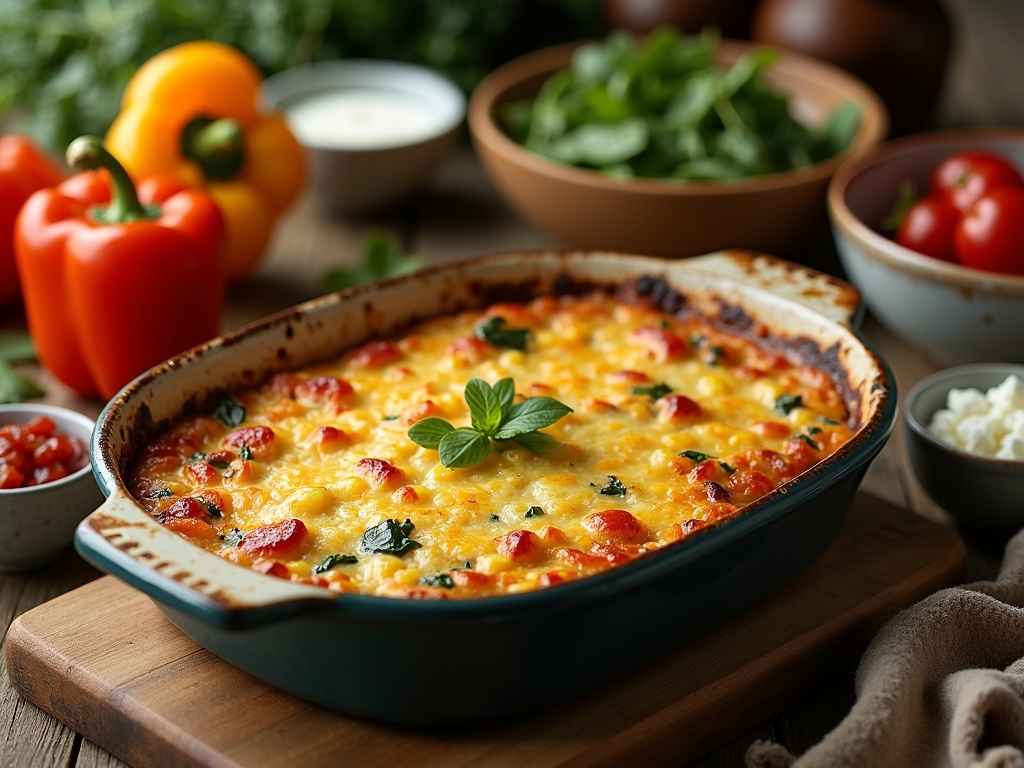Breakfast casseroles have transformed my morning routine by offering a flexible, make-ahead option that pairs convenience with nutrition. These filling dishes feature customizable layers of ingredients—from breads and proteins to vegetables and cheeses—all held together with an egg mixture that creates a satisfying meal perfect for hectic weekdays or special gatherings.
Find In This Article
Key Takeaways
- Breakfast casseroles can be prepared in advance and refrigerated overnight or frozen for up to three months, making them ideal for meal planning.
- The basic formula includes a starchy base, protein source, vegetables, cheese, and an egg mixture that can be adapted for various dietary needs.
- Popular combinations include Turkey & Cheese, Veggie Delight with spinach and feta, hearty Sausage & Hash Brown, and sweet French Toast style variations.
- A typical serving provides 25-30g of protein and balanced nutrition that helps maintain steady energy levels throughout the morning.
- For best results, use stale or toasted bread, refrigerate before baking, and ensure uniform ingredient size for even cooking.
Why Breakfast Casseroles Are Your New Favorite Make-Ahead Meal
I’ve discovered the secret to stress-free mornings – breakfast casseroles! These delicious, hearty dishes have transformed my morning routine and saved me countless hours during busy weeks. The American Egg Board reports that 70% of consumers consider eggs a key ingredient, making egg-based casseroles an obvious choice for a satisfying morning meal.
The Perfect Make-Ahead Solution
Breakfast casseroles shine as convenient make-ahead options for various occasions. I love preparing them on Sunday evenings for quick weekday breakfasts. Simply reheat a portion each morning, and I’ve got a nutritious meal ready in minutes. They’re also my go-to for holiday gatherings when I need to feed a crowd without spending the entire morning in the kitchen.
These versatile dishes combine eggs with a variety of complementary ingredients. The basic formula includes:
- A base layer (typically bread, hash browns, or tater tots)
- Protein sources (chicken, turkey, beef, or plant-based alternatives)
- Vegetables (spinach, bell peppers, onions, mushrooms)
- Cheese (cheddar, mozzarella, feta, or dairy-free options)
- Eggs and milk mixture that binds everything together
What makes breakfast casseroles truly special is their adaptability. I can easily modify recipes to accommodate dietary restrictions or preferences. For gluten-free guests, I substitute regular bread with gluten-free varieties or skip it altogether in favor of potato-based options. Vegetarian versions packed with colorful vegetables and plant proteins are just as satisfying as traditional meat-filled recipes.
The nutritional benefits can’t be overlooked either. Eggs provide high-quality protein, essential vitamins, and minerals. According to the American Egg Board, eggs deliver vital nutrients like vitamin D, choline, and antioxidants that support overall health. By starting my day with a protein-rich breakfast, I stay fuller longer and maintain steady energy levels throughout the morning.
I’ve found that breakfast casseroles are incredibly forgiving for novice cooks. The basic technique involves layering ingredients in a baking dish, pouring the egg mixture over the top, and baking until set. This simple approach yields impressive results even for those with limited culinary experience.
For busy weekday mornings, I prepare individual portions in muffin tins for grab-and-go convenience. These mini casseroles reheat beautifully and can be customized with different fillings to prevent breakfast boredom. I’ve even frozen them successfully for up to two months, making them perfect for meal planning.
The versatility extends to flavor profiles as well. I can create Southwest-inspired casseroles with black beans, corn, and chili peppers or Mediterranean versions with olives, feta, and sun-dried tomatoes. For special occasions, I’ve made decadent breakfast casseroles featuring croissants, gruyere cheese, and fresh herbs.
Beyond just taste and convenience, these dishes have become central to my family gatherings. There’s something special about pulling a golden, bubbling casserole from the oven that brings everyone to the table. The communal nature of a breakfast casserole makes it perfect for building traditions around holiday breakfasts or weekend brunches.
For those looking to expand their breakfast repertoire, I recommend experimenting with different casserole recipes to find personal favorites. The possibilities are truly endless, making breakfast casseroles one of the most versatile dishes in my cooking arsenal.

Master the Perfect Breakfast Casserole
Creating a delicious breakfast casserole isn’t complicated, but a few key techniques can transform your dish from good to spectacular. I’ve found that mastering these simple steps makes all the difference when preparing this versatile morning meal.
Essential Techniques for Success
The foundation of any great breakfast casserole starts with proper layering. I begin by placing my base ingredients (typically bread or potatoes) in a greased baking dish, followed by proteins, vegetables, and cheese before pouring the egg mixture over everything. This careful assembly ensures flavor in every bite when baked for 30-45 minutes at 350°F.
For the best texture, I always use stale or lightly toasted bread. Fresh bread tends to become soggy, while slightly dried bread absorbs the egg mixture perfectly without losing its structure. When I’m in a hurry, I toast bread cubes in the oven for 5-10 minutes to achieve this effect.
One game-changing tip I’ve discovered is refrigerating the assembled casserole before baking. Letting it rest for at least 30 minutes (or overnight) allows the flavors to meld and the bread to fully absorb the egg mixture. This simple step creates a more cohesive texture and deeper flavor profile in your casserole creation.
Food safety is non-negotiable when working with eggs. I always use a food thermometer to verify my casserole has reached an internal temperature of 160°F before serving. This ensures any harmful bacteria are eliminated while maintaining a creamy, not overcooked, texture.
For even cooking, I make sure to chop all ingredients to roughly the same size. Uniform pieces cook at the same rate, preventing some ingredients from being undercooked while others become overdone. This attention to detail ensures perfect texture in every bite of your breakfast foods.
I’ve found these casserole favorites are perfect for feeding a crowd or meal prepping for easy breakfast options throughout the week. The beauty of breakfast casseroles lies in their versatility – you can customize ingredients based on what you have on hand while following these fundamental techniques for consistent results.

Most Popular Casserole Combinations That Always Win
Breakfast casseroles have become my go-to solution for feeding a crowd or meal prepping for busy weekday mornings. I’ve discovered certain flavor combinations that consistently earn rave reviews from family and friends. These tried-and-true pairings work beautifully in the casserole format, creating meals that are greater than the sum of their parts.
Fan-Favorite Breakfast Casserole Combinations
The classic Turkey & Cheese casserole remains a crowd-pleaser for good reason. I dice smoked turkey and fold it into a fluffy egg mixture with sharp cheddar cheese. The savory protein pairs perfectly with the melty cheese, creating a satisfying breakfast that keeps hunger at bay until lunch. This combination works particularly well with a dash of dried mustard to enhance the flavors.
The Veggie Delight casserole offers a fresher take on the morning classic. I load mine with tender spinach, colorful bell peppers, sweet onions, and tangy feta cheese. The vegetables add wonderful texture and nutritional value, while the feta provides a Mediterranean twist that elevates the entire dish. It’s a great option for vegetarian guests or anyone looking to add more veggies to their morning routine.
For hearty appetites, nothing beats a Sausage & Hash Brown casserole. I layer seasoned ground sausage with crispy hash browns, eggs, and plenty of cheese. The starchy potatoes form a satisfying base, while the sausage adds rich flavor throughout. This combination is especially popular during cold winter months when people crave something substantial to start their day. For a similar concept with a twist, you might enjoy trying a tater tot casserole variation.
When I’m in the mood for something sweet, the French Toast Style casserole hits all the right notes. I arrange bread slices in a baking dish, pour over a custard mixture, and top everything with a cinnamon-sugar blend. After baking, the result is a caramelized top with a pudding-like interior that tastes like a special occasion breakfast but requires minimal morning effort.
According to consumer preference studies, 62% of people prefer savory versions over sweet options when it comes to breakfast casseroles. This might explain why egg-based options dominate most 5-star casserole favorites lists.
What makes these combinations so successful is their balance of flavors and textures. I’ve found that the best casseroles include:
- A protein component (meat or vegetarian alternatives)
- A starchy element (potatoes, bread, or grains)
- Something creamy (cheese, eggs, or milk)
- Seasoning that ties everything together
The beauty of these popular combinations is how easily they can be customized. I often adapt them based on what’s in my refrigerator or seasonal ingredients. They’re perfect for easy breakfast preparation when time is limited but you still want something satisfying.
For anyone looking to expand their breakfast foods repertoire, these casserole combinations provide an excellent starting point. They’re reliable enough for special occasions yet simple enough for everyday meals, striking that perfect balance between comfort and creativity.

What’s Really in Your Breakfast Casserole
Ever wondered what nutritional value you’re getting from that delicious breakfast casserole you’ve just pulled from the oven? I’ve done the research to break down exactly what goes into each serving of these morning favorites.
A standard serving of breakfast casserole (typically 1/6 of a 9×13 dish) packs a substantial nutritional punch. Let’s take a closer look at what you’re consuming with each delicious forkful.
Nutritional Breakdown
When I dig into a typical breakfast casserole serving, I’m getting approximately 350-500 calories. That might seem high compared to a simple bowl of cereal or toast, but these calories come with significant nutritional benefits.
Each serving provides about 25-30g of protein, which helps keep me full throughout the morning and provides essential building blocks for my body. This protein content is particularly impressive when compared to many traditional breakfast options like pancakes or pastries.
The carbohydrate content hovers around 30-35g per serving. These carbs come from ingredients like:
- Bread or potatoes forming the base
- Vegetables mixed throughout
- Milk used in the egg mixture
- Optional ingredients like beans or grains
Fat content typically ranges from 15-25g per serving, depending on ingredient choices. While this might seem high, I can easily modify recipes to include leaner proteins or reduced-fat dairy to bring this number down.
Yes, breakfast casseroles tend to be higher in calories than some traditional breakfast options, but they offer important advantages. I find the portion control aspect particularly helpful – when I make a tater tot casserole or egg-based morning bake, I can easily divide it into precise portions, helping me manage my intake more effectively.
What makes these dishes particularly valuable is their versatility. I can boost the nutritional profile by adding extra vegetables, swapping in whole grains, or using lean proteins. For instance, incorporating spinach, bell peppers, and lean turkey sausage significantly increases the vitamin and mineral content while maintaining that satisfying taste.
The protein-to-carb ratio in most easy breakfast casseroles helps stabilize blood sugar levels, preventing the mid-morning crash that often comes with carb-heavy options like pastries or sugary cereals.
For those monitoring their macros, breakfast casseroles can be adjusted to fit nearly any dietary plan. Looking for lower carbs? I focus on egg-based recipes with fewer potatoes. Need more protein? I add extra egg whites or lean meats. Want a lighter option? I substitute heavy cream with milk or even plant-based alternatives.
What truly sets breakfast casseroles apart is their efficiency as meal prep options. When I make a full dish on Sunday, I’m setting myself up for several days of nutritionally balanced breakfasts without the morning rush. This planning aspect has helped me avoid the pitfall of skipping breakfast or grabbing less nutritious convenience foods.
For families, these casserole favorites provide an opportunity to start the day with a balanced meal that satisfies various preferences while delivering substantial nutrition. The customizable nature allows me to sneak in vegetables or other healthy ingredients that might otherwise be rejected as standalone items.
Smart Storage and Serving Tips
One of the best things about making breakfast casseroles is their practicality for feeding groups. A standard 9×13 inch casserole typically serves 6-8 people, making it perfect for family gatherings or when you have overnight guests. I find this serving size ideal because it gives everyone a hearty portion without leaving too many leftovers.
Proper Storage Methods
When it comes to storing your breakfast foods like casseroles, proper techniques make all the difference in maintaining flavor and texture:
- Refrigeration: After completely cooling, cover with plastic wrap or aluminum foil and store in the refrigerator for 3-5 days.
- Freezing: For longer storage, wrap portions tightly in freezer-safe containers or heavy-duty aluminum foil for up to 3 months.
- Portion control: Consider cutting into individual servings before freezing for quick grab-and-heat meals.
- Labeling: Always mark containers with the date to track freshness.
Reheating frozen casseroles correctly preserves their taste and texture. For best results, thaw overnight in the refrigerator if possible, then heat in a 350°F oven for 15-20 minutes until the internal temperature reaches 165°F. If reheating from frozen, you’ll need to extend the cooking time to about 45 minutes, covering with foil for the first half to prevent over-browning.
Serving Suggestions
Easy breakfast casseroles become complete meals with thoughtful pairings. I recommend balancing the richness of dishes like tater tot casserole with lighter sides:
- Fresh fruit platters offer a sweet contrast to savory casseroles and add nutritional value.
- A simple green salad dressed with light vinaigrette cuts through the richness of egg-based dishes.
- For a special touch, provide a selection of sauces or condiments like hot sauce, salsa, or a dollop of Greek yogurt instead of sour cream.
For hosting larger gatherings, I’ve found that setting up a casserole buffet works brilliantly. Prepare a few different casserole favorites—perhaps one vegetarian option and one meat-focused version—alongside a selection of sides and beverages. This allows guests to customize their plates according to their preferences and dietary needs.

Sources:
American Egg Board; “Consumer Insights on Eggs in Breakfast Foods”
The USDA Food Composition Databases; “Nutritional Profiles of Common Breakfast Ingredients”
Bon Appétit; “Breakfast Casseroles: A Complete Guide”
Food Network; “Top 10 Breakfast Casserole Recipes”

